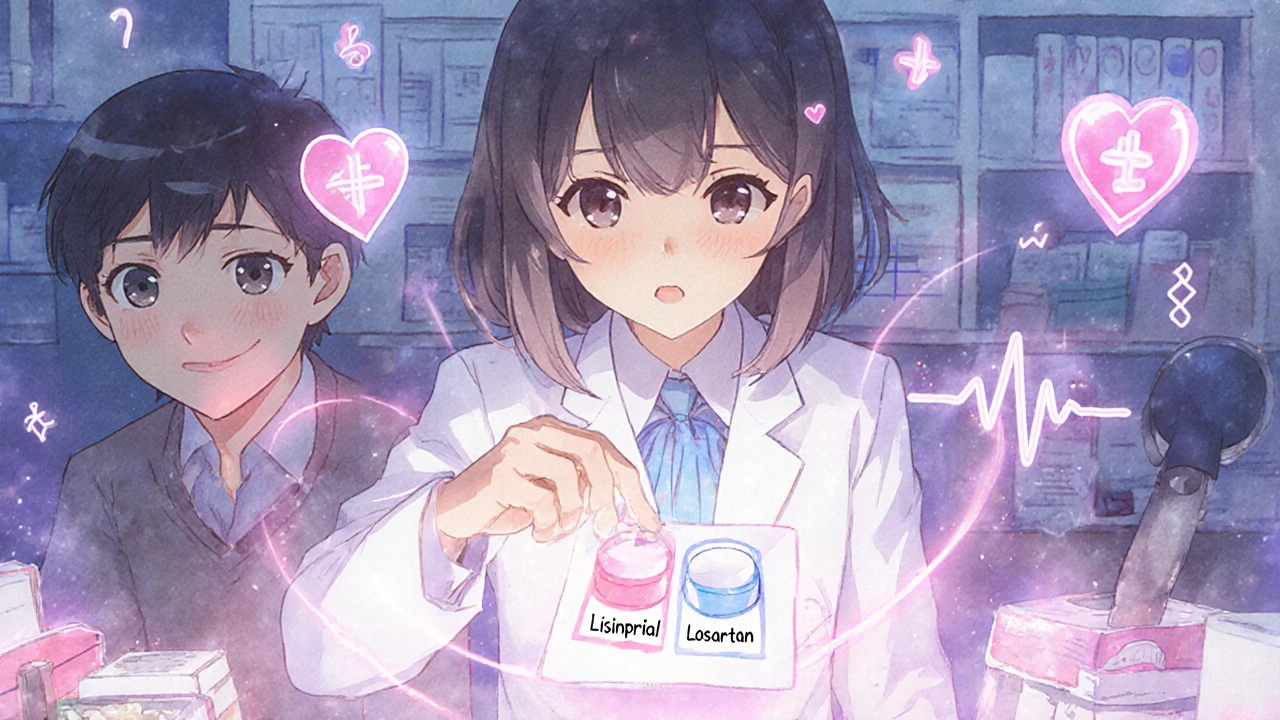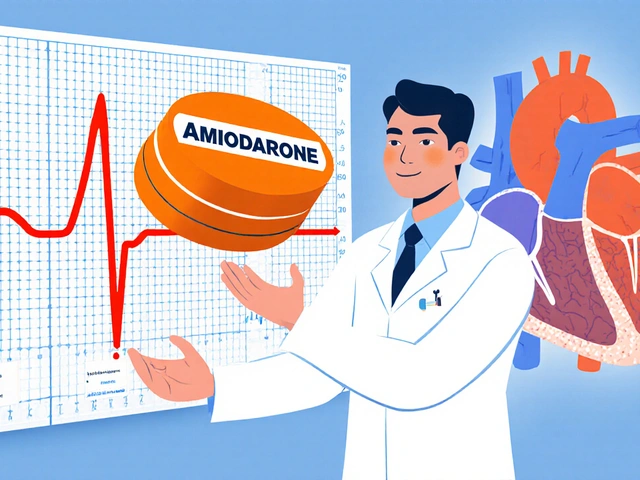When a doctor prescribes a medication and the pharmacist gives you a different pill with the same purpose, it’s easy to assume they just swapped one brand for another. But if the new drug isn’t just a generic version-it’s from a different brand within the same class, like switching from lisinopril to losartan for high blood pressure-that’s not generic substitution. That’s therapeutic interchange. And it’s not random. It’s a carefully planned, evidence-based decision made by a team of clinicians, not a pharmacist acting alone.
Therapeutic interchange isn’t about switching drug classes
A lot of people get this wrong. Therapeutic interchange doesn’t mean swapping a blood pressure drug for a cholesterol drug. That would be dangerous and inappropriate. Instead, it means swapping one drug for another within the same therapeutic class-like switching from one ACE inhibitor to another, or one statin to another. The goal isn’t to change the treatment goal; it’s to find a better fit for the patient, often at a lower cost, without losing effectiveness.The American College of Clinical Pharmacy defines it clearly: therapeutic interchange is replacing a prescribed medication with a chemically different one that’s expected to deliver substantially the same clinical results. That’s it. No jumping between classes. No guessing. It’s based on data, not convenience.
For example, if a patient is prescribed atorvastatin for high cholesterol but the hospital’s formulary prefers rosuvastatin because it’s equally effective and cheaper, a pharmacist might make the switch-only if the Pharmacy and Therapeutics Committee has approved it, and only if the patient’s condition supports it. The outcome? Same goal: lower LDL cholesterol. Different pill. Same result.
Who decides when a switch happens?
This isn’t something a pharmacist does on a hunch. Every therapeutic interchange is governed by a formal process led by a Pharmacy and Therapeutics (P&T) Committee. These committees include pharmacists, physicians, nurses, and sometimes even patients or family representatives. They review clinical studies, cost data, side effect profiles, and real-world outcomes to build a formulary-a list of preferred medications for specific conditions.Once that list is set, pharmacists can swap medications on it without needing a new prescription every time. But here’s the catch: they can’t just pick anything. The alternatives on the formulary have been vetted. For heart failure, maybe only lisinopril, enalapril, and ramipril are approved for interchange. Nothing outside that group. That’s how they avoid unpredictable outcomes.
These committees don’t just set rules-they monitor them. They track how often switches happen, whether patients have better outcomes, and if costs actually drop. In skilled nursing facilities, these programs have saved tens of thousands of dollars per month. But the savings aren’t the only metric. Patient safety is always the priority.
Why hospitals use it-cost isn’t the only reason
You might think therapeutic interchange is just about saving money. And yes, it helps. Drug prices rose 8% in 2018 alone, and hospitals can’t absorb those costs forever. But the real value is in standardizing care.Hospitals and long-term care facilities treat hundreds of patients with the same conditions. If everyone gets the same preferred drug, it’s easier to predict side effects, manage interactions, and train staff. It reduces errors. It makes it easier to track which treatments work best across populations.
For instance, if a hospital switches all new patients with type 2 diabetes to metformin instead of multiple other oral agents, they can quickly see how well metformin works in their specific patient group. If it leads to fewer hypoglycemic episodes or better A1C control, they stick with it. If not, they adjust. That’s evidence-based medicine in action.
It’s not just about cost. It’s about consistency, safety, and quality. The American Heart Association says these programs have been used in hospitals for decades because they support a single, reliable formulary system. That system doesn’t just cut costs-it improves outcomes.
Why it rarely happens in community pharmacies
You won’t see this happen often at your local CVS or Walgreens. Why? Because community pharmacies don’t have the same formulary systems. There’s no P&T committee reviewing data and approving switches. Pharmacists there can’t just swap a brand-name drug for another from the same class without checking with the prescriber first.In fact, research shows therapeutic interchange rarely occurs in community settings unless the pharmacist calls the doctor and gets permission. That’s because state laws vary. Some states allow pharmacists to make substitutions under standing orders. Others require a new prescription every time. And even in states that allow it, most prescribers don’t sign the necessary authorization letters.
That’s why therapeutic interchange is mostly an institutional practice. It needs structure: a formulary, a committee, documentation, and prescriber buy-in. Community pharmacies operate on a different model-fill prescriptions, not redesign treatment plans.
What happens if the switch doesn’t work?
Therapeutic interchange isn’t foolproof. Sometimes the alternative drug causes side effects the original didn’t. Or maybe the patient had a bad reaction to it before. That’s why the ACCP guidelines say there must be clear exceptions built into the process.Every good therapeutic interchange program includes a way to reverse the change. If a patient starts feeling dizzy after switching from one beta-blocker to another, the pharmacist or nurse flags it. The prescriber is notified. The original drug is reinstated. No penalty. No blame. Just a quick course correction.
Successful programs track these reversals. They don’t see them as failures-they see them as feedback. That’s how they improve. They update the formulary, add notes about which patients to avoid switching, or require extra monitoring for certain combinations.
This is why patient-centered care matters. The American Heart Association stresses that decisions should include input from the patient and their family. If someone says, “I’ve been on this pill for ten years and it’s the only thing that worked,” that’s not just preference-it’s clinical history. And it matters.

What providers need to know before agreeing
For doctors, signing off on therapeutic interchange isn’t just a formality. It’s a responsibility. That’s why many facilities require a “TI letter”-a signed document from the prescriber authorizing the switch for a specific patient or condition. Once signed, the pharmacy can automatically substitute the approved drug every time it’s prescribed.But signing that letter means you’ve reviewed the evidence. You’ve considered alternatives. You’ve thought about your patient’s history. You’ve accepted that the switch is clinically appropriate. It’s not a blanket approval. It’s targeted.
Some prescribers resist because they worry about losing control. But the goal isn’t to replace their judgment-it’s to support it with better tools. When done right, therapeutic interchange frees up time. Instead of debating which statin to use, the doctor can focus on whether the patient is exercising, managing stress, or adhering to the regimen.
The future of therapeutic interchange
Therapeutic interchange isn’t going away. With drug prices still rising and healthcare systems under pressure, it’s one of the most reliable ways to control costs without sacrificing quality. More institutions are adopting it. More states are updating their laws to support it.But the biggest change isn’t in policy-it’s in how it’s done. Future programs will use real-time data. They’ll flag patients who’ve had adverse reactions to certain drugs. They’ll integrate with electronic health records to auto-suggest alternatives based on allergies, kidney function, or other meds. They’ll even learn from patient-reported outcomes.
One thing won’t change: therapeutic interchange will always stay within drug classes. It won’t become a loophole to swap insulin for metformin or amoxicillin for azithromycin. That’s not interchange. That’s error. And the system is built to prevent it.
At its core, therapeutic interchange is about doing the right thing for the patient-not the cheapest thing, not the easiest thing, but the best thing based on the best available evidence. And that’s something every provider should support.
Is therapeutic interchange the same as generic substitution?
No. Generic substitution means replacing a brand-name drug with its exact chemical copy-like switching from Lipitor to atorvastatin. Therapeutic interchange swaps one drug for another in the same class that’s chemically different but clinically similar-like switching from atorvastatin to rosuvastatin. Generics are identical in active ingredient; interchangeable drugs are different compounds with similar effects.
Can a pharmacist make a therapeutic interchange without the doctor’s permission?
In most cases, no. In community pharmacies, pharmacists must contact the prescriber before switching. In hospitals or long-term care facilities, switches can happen automatically-but only if the prescriber previously signed a formal authorization (a TI letter) and the drug is on the approved formulary. Even then, the pharmacist must follow strict protocols.
Why do some drugs have more interchangeable options than others?
It depends on clinical evidence. For blood pressure meds like ACE inhibitors, there are many studies showing different drugs in the class work similarly. For others, like certain antidepressants or antipsychotics, the differences in side effects or effectiveness are too large to justify interchange. Formularies only include alternatives where data supports equivalent outcomes.
Does therapeutic interchange affect patient outcomes?
When done correctly, it can improve outcomes. Standardizing care reduces errors, ensures consistent dosing, and helps teams monitor effectiveness. Studies show fewer adverse events and better adherence in facilities with strong therapeutic interchange programs. But if the wrong drug is chosen-or if the patient’s unique needs are ignored-it can hurt outcomes. That’s why evidence and individualization matter.
Are there any risks in using therapeutic interchange?
Yes. The main risk is assuming all drugs in a class are equal. For example, switching from one diuretic to another might be fine for mild hypertension, but not for someone with kidney disease. Or switching from one statin to another might increase muscle pain in some patients. That’s why formularies include warnings, exceptions, and monitoring rules. The system only works if it’s not used blindly.








12 Comments
Levi Hobbs
November 17, 2025 AT 12:53Therapeutic interchange is one of those quiet miracles in healthcare that nobody talks about-but it saves lives and money every single day. I’ve seen pharmacists catch a dangerous interaction because they swapped a statin with a better renal profile for a patient with CKD. No fanfare. No press release. Just a well-trained team doing their job right.
It’s not about cutting corners. It’s about using data to eliminate guesswork. When every doc and pharmacist is on the same formulary, you reduce errors, standardize monitoring, and actually start measuring what works-not what’s cheapest or most advertised.
And yeah, it’s not magic. You need oversight. You need exceptions. You need patient input. But when those pieces are in place? It’s the closest thing we’ve got to precision medicine at scale.
henry mariono
November 18, 2025 AT 19:25Interesting read. I’ve never thought about how much structure goes into something that seems so simple-like getting a different pill at the pharmacy. Makes me wonder how many people assume their med was changed because of insurance, when it’s actually a clinical decision.
Sridhar Suvarna
November 20, 2025 AT 11:47From India where drug pricing is a daily battle-this is not just smart, it’s essential. Here, even generics are unaffordable for many. Therapeutic interchange allows us to stretch limited resources without compromising outcomes. The P&T committee model works-especially in public hospitals where we treat 500 hypertensive patients a week. We don’t have luxury of trial and error. We need evidence, not ego.
And yes, patient feedback matters. We’ve stopped swapping lisinopril for some elderly patients after they reported chronic dry cough-switched to amlodipine instead. Simple. Effective. Human.
Joseph Peel
November 21, 2025 AT 00:52There is a fundamental misunderstanding in public discourse regarding therapeutic interchange versus generic substitution. The former is a pharmacotherapeutic optimization strategy grounded in clinical trials and real-world evidence; the latter is a regulatory and economic mechanism designed to reduce cost through chemical equivalence. Confusing the two undermines both patient safety and the integrity of clinical decision-making.
Furthermore, the absence of formalized formularies in community pharmacy settings is not a failure of the model-it is a structural limitation of the retail pharmacy business model, which prioritizes speed and volume over clinical deliberation. This is not a criticism of pharmacists-it is an indictment of the system.
Kelsey Robertson
November 21, 2025 AT 06:01Oh, so now we’re just going to let pharmacists decide what drugs we take? Because clearly, doctors are too busy being ‘in control’ to actually care about their patients.
And let me guess-the ‘P&T Committee’ is just Big Pharma in lab coats, right? They’re not pushing cheaper drugs because they’re better-they’re pushing them because they’re paid off.
Next thing you know, they’ll swap my antidepressant for a supplement that ‘works just as well’-and then tell me I’m ‘non-compliant’ when I feel worse.
And don’t even get me started on how ‘standardizing care’ means they’ll stop listening to me. I’ve been on the same med for 12 years. I’m not a statistic. I’m not a cost-center. I’m a person.
And if you think I’m okay with some faceless committee swapping my meds without my say-so? You’re delusional. This is how we lose autonomy. This is how we become patients, not people.
And don’t give me that ‘evidence-based’ nonsense. Evidence is just what they say it is. I’ve seen what happens when ‘protocols’ override individual needs. It’s not medicine. It’s assembly-line healthcare.
And yes, I’ve read the AHA guidelines. I’ve also read the lawsuits. I know how this ends.
Joseph Townsend
November 22, 2025 AT 08:07Let me tell you what really happens behind the scenes: the P&T committee meets, they’re all tired, someone yells ‘We need to cut $20K this quarter,’ and suddenly everyone’s on rosuvastatin-even the guy with a history of rhabdo.
It’s not science. It’s spreadsheet medicine. They don’t care about your kidney function, your sleep, your anxiety, your dog that dies every time you take a new pill. They care about the bottom line.
And don’t even get me started on the ‘TI letter.’ That’s just a fancy way of saying, ‘We’re going to change your med and you’re not allowed to complain unless you file paperwork.’
It’s not patient-centered. It’s profit-centered. And if you think it’s different in hospitals? Honey, the same people who run the pharmacy are the ones who get bonuses based on cost savings.
This isn’t innovation. It’s corporate control dressed up in white coats.
And yes-I’ve been switched twice. Both times I felt like crap. Both times I had to fight to get back on my original med.
So don’t call it ‘evidence-based.’ Call it ‘evidence-bent.’
Bill Machi
November 22, 2025 AT 18:32Who the hell let a bunch of bureaucrats in white coats decide what I take? This is socialism in a pill bottle. We used to have doctors who knew their patients-not some panel of bureaucrats with a spreadsheet and a PowerPoint.
And don’t give me that ‘standardized care’ crap. Standardized is what you get when you stop thinking. You want consistency? Fine. But don’t tell me that’s better than individualized care. I’ve seen people die because they got the ‘preferred’ drug and it didn’t work for them.
This isn’t healthcare. It’s corporate rationing. And if you’re okay with that, you’re part of the problem.
Next they’ll be swapping insulin for metformin because ‘it’s cheaper.’ And then we’ll be blaming the patient for not ‘adhering’ to the new protocol.
Wake up. This is how they take control. One pill at a time.
Elia DOnald Maluleke
November 24, 2025 AT 17:01In the grand tapestry of medical ethics, therapeutic interchange is not merely a logistical maneuver-it is a philosophical act. It asks: Who holds the authority over the body? The physician? The pharmacist? The algorithm? The insurer?
When we replace one molecule with another-not because it is identical, but because it is ‘equivalent’-we are not merely changing a drug. We are changing the relationship between patient and healer.
And yet, in systems starved of resources, this act becomes a sacred compromise: the dignity of individuality, weighed against the survival of the collective.
It is not perfect. It is not pure. But in a world where a child in Cape Town cannot afford a statin, and a veteran in Ohio is rationing insulin-this is not betrayal. It is survival with conscience.
Let us not mistake necessity for corruption. Let us not confuse pragmatism with surrender.
Perhaps the true question is not whether we interchange drugs-but whether we have the courage to interchange our assumptions about care itself.
satya pradeep
November 25, 2025 AT 10:53Bro this is so real. In India we use this all the time because prices are insane. One guy on ramipril got switched to enalapril because it was half the price and same effect. He was fine. No drama. But if someone had history of angioedema? They skip it. Simple.
Also, doctors here often sign those TI letters because they know it saves time. No need to re-prescribe every time. Win-win.
But yeah, in US community pharmacies? Totally different. Pharmacist can’t do jack without calling doc. That’s why people think it’s just insurance forcing a switch. It’s not. It’s just broken system.
Prem Hungry
November 27, 2025 AT 00:52Hey, just wanted to say this is one of the clearest explanations I’ve read on therapeutic interchange. I’m a nurse in a long-term care facility, and we use this daily. Patients get better outcomes because everyone’s on the same meds. Less confusion. Fewer errors. Less stress for staff and families.
And yes-we do reverse switches when needed. One lady had a bad reaction to a new beta-blocker. We called her cardiologist, she got her old med back in 2 hours. No blame. Just care.
Don’t let the fear-mongers scare you. This isn’t about control. It’s about doing the right thing, the right way, for the most people. And that’s worth fighting for.
Leslie Douglas-Churchwell
November 27, 2025 AT 02:46So… let me get this straight. You’re telling me that a committee of ‘experts’-who probably get kickbacks from pharma-can swap my life-sustaining medication for a ‘similar’ one… while my EHR is being sold to data brokers… while my insurance is denying my original prescription… while the FDA is asleep at the wheel?
And you call this ‘evidence-based’? 😏
It’s not interchange. It’s a Trojan horse for corporate medicine. They don’t care if you get dizzy. They care if the stock price goes up.
And don’t even mention ‘patient input’-unless you’re the one signing the consent form in 12-point font while your vision is blurred from the new med.
They’re not saving money. They’re sacrificing you. And you’re applauding.
💉 #PharmaControl #NotMyMed #TherapeuticInterchangeIsACoup
shubham seth
November 28, 2025 AT 17:27Therapeutic interchange is a fucking joke. You think this is science? It’s a fucking cost-cutting gimmick disguised as clinical wisdom. They pick the cheapest drug in the class and call it ‘equivalent’-but everyone knows some of these drugs have different half-lives, different metabolites, different side effect profiles. You swap a long-acting ACE inhibitor for a short-acting one and suddenly the patient’s BP spikes at night. Who fixes that? The pharmacist? The committee? Nah. The patient gets blamed for ‘non-compliance.’
And don’t even get me started on the ‘TI letter.’ That’s not authorization-it’s liability laundering. The doc signs it so they don’t get sued when the patient has a stroke because they switched from lisinopril to benazepril without checking renal function.
This isn’t innovation. It’s negligence with a PowerPoint.